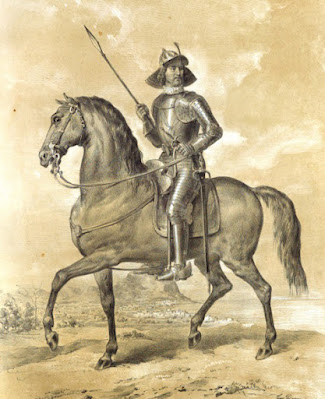Reprinted from Western Exile @westernexile
Origin: Normandy
States: Kingdom of Sicily, Kingdom of Naples, First French Empire, Kingdom of Italy
Highest Titles: Prince of Arianello, of Cutó, of Mirto, of Satriano, Duke of Cardinale, of Taormina
Heraldic Blazon
Argent a Cross Azure
Following the conquest of Jerusalem in the First Crusade, Richard of Arnes, ancestor of the Filangieri, is said to have adopted the cross, choosing blue to symbolise that his endeavours had been in the service of the King of Heaven.
Heraldic Variants
As the family split into multiple branches, numerous variations on the dynastic arms arose. The Filangieri of Sicily, for example, added nine bells in remembrance of their having sounded the alarm that unleashed the revolt of the Sicilian Vespers in 1282.
Other variants include the label of three points gules granted to the Filangieri by Charles I of Anjou, while following the Austrian conquest of the Italian South in 1720, Emperor Charles VI permitted the family to charge their arms upon the Imperial Eagle.
Extended TitlesDue to the antiquity and extent of the dynasty and its branches, across the centuries the Filangieri would hold at least 109 fiefdoms, and amass an extraordinary list of titles, including 16 countships, 2 marquisates, 8 dukedoms and 6 princeships.Overview
The sources largely agree that the Filangieri trace their origins to a certain Richard 'Angerius' of Arnes, who in the wake of the Norman conquest of the Italian South, followed the famed adventurer Robert Guiscard and settled in the Principality of Salerno in 1045.
In 1096, Angerius would serve with distinction alongside Godfrey of Bouillon and other Norman lords of the South on the First Crusade. Rewarded with many fiefdoms, it is indeed from he that the Filangieri derive their name - 'filii Angerii' - 'Sons of Angerius'.
For almost the entirety of the existence of the Southern Kingdoms, under the Hauteville, Hohenstaufen, Angevin, Aragonese, Habsburg and Bourbon kings, and beyond into modern times, the Filangieri would occupy the utmost positions of civil and military prominence.
As a result of their sustained pre-eminence, through fortune, misfortune, intrigue, marriage and prowess the Filangieri would steadily establish a multitude of branches across the Neapolitan and Sicilian realms, many of which flourished in their own right.
Emblematic of the pre-nation state world, the Filangieri often distinguished themselves abroad, serving at times Spain, Austria and even Napoleon Bonaparte. Yet the rise of nationalism, which the Filangieri fought both for and against, would herald their decline.
The conquest of the South in 1860, and consolidation of the united Italian state, would see the Filangieri largely fade from political prominence, though the family has continued to produce prominent intellectuals, from historians to economists, to this day.
Illustrious MembersRichard 'Angerius' d'Arnes (pre 1045-1104)
The progenitor of the Filangieri, Richard was the first of the line to arrive in Italy from Normandy, sealing the family's rise with the valour he showed on the First Crusade.
Riccardo Filangieri (c. 1195-1278)
Like his ancestor, Riccardo would also distinguish himself in the Holy Land, fighting in the Sixth Crusade under Emperor Frederick II, before siding against the Empire in the resulting civil war.
Gaetano Filangieri (1753-1788)
Among the most prominent philosophers of 18th century Italy, Gaetano's eloquent advocacy for legal reform in the face of the Enlightenment won him the support of King Ferdinand of Bourbon, before his premature death.
Carlo Filangieri (1784-1867)
The most controversial, and therefore famed, member of the dynasty, the life of Carlo would span 83 years that changed his homeland, and Europe, forever, in events that he himself would be more than a passive observer to.
By quirk of fate, Carlo would be granted military command in the First Empire as a result of Napoleon's admiration for his father Gaetano. Unfortunately, this would lead to his treason, when he accompanied the French army in its invasion of the Kingdom of Naples in 1806.His loyalty to the Napoleonic cause would see his career blossom in Italy and in Spain, as aide-de-camp to the Emperor's brother-in-law Joachim Murat. Fortunately for him, following King Ferdinand's restoration in 1815, he was reconciled with the Bourbon monarchy.When Europe was convulsed by revolution in 1848, Carlo would lead the Bourbon army to victory over the nationalist junta that seized the government of Sicily, though his triumph was marred by the high civilian casualties that resulted from the siege of Messina.In 1859 an elderly Carlo served as Prime Minister to Ferdinand II, where his proposal of a Faustian alliance with the nationalist government of Turin came to naught. Unable and unwilling to stem the onslaught of the subsequent invasion, he submitted to the new Italian state.Gaetano Filangieri (1824-1892)A connoisseur of the arts and renowned scholar of Neapolitan history, Gaetano played a decisive role in the protection of the cultural heritage of Naples, as well as in many of the city's learned societies.Architectural Legacies
The Filangieri Museum, Naples
Determined to prevent the government from demolishing the historic Palazzo Como, in 1882 Gaetano Filangieri transformed it into a museum at his own expense, donating a vast collection of his curiosities to populate it.
Palazzo Mirto, Palermo
Crowning a meteoric career loyal to the Spanish Crown, in 1683, former Praetor of Palermo Don Vincenzo Filangieri, Prince of Mirto, transformed the family palace into one of the most sumptuous residences of the Sicilian capital.































